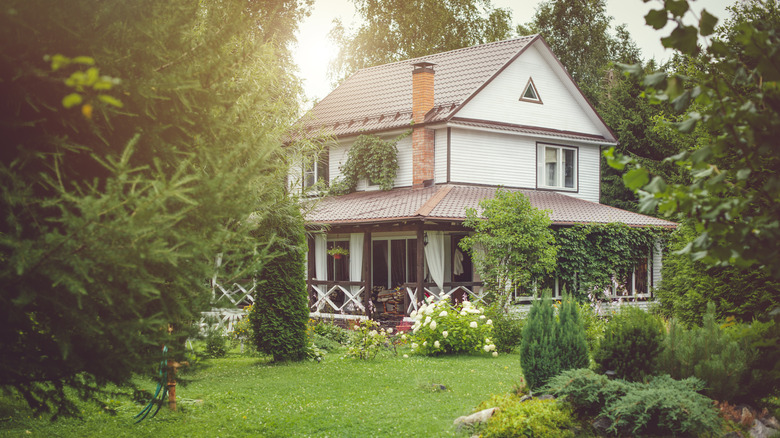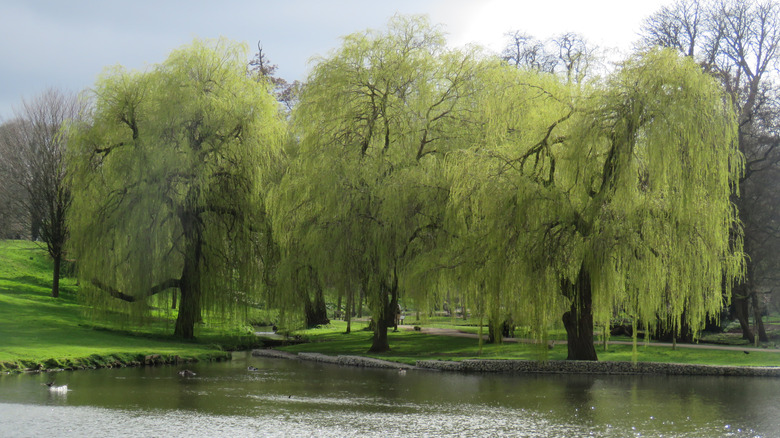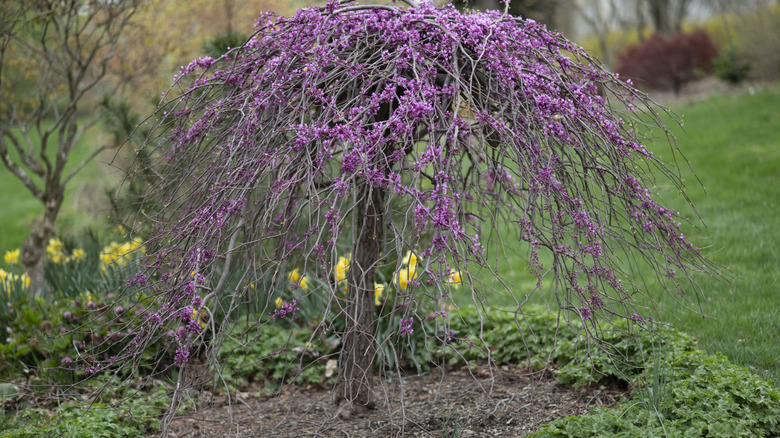The Popular Tree You Shouldn't Grow Near Your House (& What To Plant Instead)
With their tumbling branches boasting a waterfall of leaves, weeping willows are like something out of a storybook. These majestic trees seem harmless as they sway quietly beside a stream or shift in a hilltop breeze. But when planted too close to home, the weeping willow (Salix babylonica) can cause a great deal of damage — so much so that most arborists recommend keeping this deciduous specimen at least 50 feet from any structures, sidewalks, or pipes.
The weeping willow is an incredibly fast-growing tree, both above and below ground. This vigorous habit requires a constant and ample supply of water, one that the willow's quickly spreading roots will travel quite far for. If the closest source of water happens to be on your property, the roots won't hesitate, and these woody tendrils can cause costly damage to outdoor pools, septic systems, and plumbing.
Instead, consider adding the Eastern redbud (Cercis canadensis) to your landscape. Despite its maximum mature height of 30 feet, the Eastern redbud is a slow-growing, easy-to-maintain tree that still brings the wow factor: In spring, this early bloomer's branches are gilded with magenta-pink flowers that signal warmer weather is on its way.
A weeping willow's thirst knows no bounds
Willows, native to China, are vigorous growers whose roots will travel a significant distance to reach water, sometimes up to three times the width from the trunk to the edge of the canopy. While this helps the tree retain moisture during dry periods, it also means your home could be in its crosshairs. A weeping willow's vast root system can easily disrupt water and sewer lines, pools, septic tanks, sidewalks, and even your home's foundation. This can lead to costly damage and even put the structural integrity of your home at risk.
This expedited growth has another downside: brittle wood. Weeping willows may grow more than 2 feet per year, but their flexible new branches tend to be thin and fragile. While they are strong enough to support the tree's delicate leaves, these branches are much more susceptible to breakage than other, sturdier trees like oaks and maples. It's common to see lots of debris around a weeping willow, especially after a windy storm. And if winter brings a heavy, wet snow, the weight can easily cause branches to snap.
Luckily, there are plenty of low-maintenance trees to choose from. For all the grace of a willow and none of the consequence, liven your property with an Eastern redbud tree, which even comes in weeping varieties. With a more controlled habit, slower growth, and a less aggressive root system, the Eastern redbud makes a great alternative for your landscape while adding a touch more color to your spring.
Eastern redbud trees are an easy and colorful alternative
The Eastern redbud, a vibrant tree with stunning color, is native to North America and a landscaping staple across the country. These deciduous trees grow well in most climates (USDA Hardiness Zones 4 to 9) and require minimal care to thrive. They also serve as a beacon for the incoming spring, as their bare branches start to burst with bright pink buds in late March and early April. Like cherry blossoms, these blooms only last a few weeks, but they leave a regal red carpet beneath the canopy as they drop.
Redbuds grow much slower than willows, and although they can hit 20 to 30 feet at maturity, they are easily managed with regular pruning. They also require far less water than a weeping willow, and their roots don't usually pose a threat to your home or property. Plus, they're a beautiful addition to the landscape all year: Spring blossoms fade to thick, heart-shaped leaves that form a golden-red canopy in fall.
If you're still after the weeping look, you're in luck — there are a handful of popular weeping redbud varieties available. These include 'Covey', also called 'Lavender Twist' for its deep purple color and curving branches. Many of these weeping cultivars are considered dwarf trees, maturing to a manageable 5 to 15 feet, making them ideal for the urban or suburban landscape.


